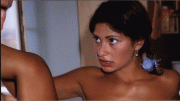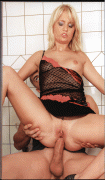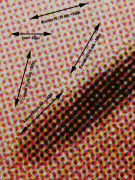 Register on the forum now to remove ALL ads + popups + get access to tons of hidden content for members only!
Register on the forum now to remove ALL ads + popups + get access to tons of hidden content for members only!
|
||||||||
 Best Porn Sites Best Porn Sites
|
Live Sex | Register | FAQ | Members List | Calendar | Mark Forums Read |
 |
|
|
Thread Tools | Display Modes |
|
|
#1 |
|
Senior Member
Join Date: Feb 2008
Location: Germany
Posts: 161
Thanks: 98
Thanked 1,062 Times in 160 Posts
           |
I think there are some threads about how to scan and which settings to use, but I want to share my thoughts about how to get the best quality in terms of resolution and smoothness, without taking the processing time into account...
Some details might be too technical, so I'll try to keep it short. But if there is interest, I can go into more detail. Color printing is usually done as 4-color CMYK print with a regular screen and AM pattern. This means that the original image is split into Cyan, Magenta, Yellow and Black. For each part, a regular screen is used, and the dot size varied according to the intensity. The four screens (a grid of dots) are overlayed at different angles. I analyzed a few magazines: An early CCC (~1977), one of the last CC (~2000), as well as the first and last Silwa issues (2002 and 2007). The analysis was done using a macro lens and a DSLR, where a sample shot had effective 3200dpi or more. A 1200dpi scan is just enough to guess the screen angles and resolutions of 130~160lpi screens. According to my analysis, the magazines use the same screen angles: C=15°, M=45°, Y=0°, K=75°. The old CCC magazine used a screen of about 133lpi for all colors. The other three magazines used a screen of about 140lpi for CMK, and a slightly higher resolution of about 155-160lpi for Y. BTW: I also checked a "New Climax" Magazine. I have no evidence, but I think these are using Hexachrome Print (CMYKOG with Orange/Green). The screen resolution is about 405lpi for yellow, and 380lpi for the other colors. The amount of detail is really incredible. Maybe I check how much resolution can be squeezed out of this hi-res print. If the scan resolution comes near the resolution of the print screen, then you will most likely get horrible Moiré or interference. On many scans you can see a yellow-ish speckle, this might be related with the different screen resolutions of the yellow print. Once you have a low-frequency moiré or interference, there is no way to remove it by image editing. The only way is to avoid these effects. Therefore, scanning must be done at significantly lower or higher resolution than the print screen resolutions used. Other issues are, of course, color calibration, dynamic range and reproduction of highlight/Shadow, but theses are different topics... 1) Capturing For a 140lpi/160lpi screen, scanning at 600dpi without de-screening is a good solution. I would suggest at least 2x the highest screen value. This should capture a fairly good image of the individual color dots. Once the pages are scanned, adjusted in angle, cropped and saved, all other steps can be done with batch-processing, once the best set of parameters is determined. 2) De-Screening De-screening can be done with gaussian blur. You want the individual points to "melt" so that all pixels are filled. This means that you want to blur an imaginary spot up to the corner of a surrounding square. You calculate the ratio of the scan resolution and the coarsest screen, in our example 600/140. That's the ratio of captured resolution and the print resolution. To get the radius for the gaussian blur, you have to multiply this ratio with SQRT(2)/2, about 0.707. That's 3.03 in our example. Because you want a smooth image, you round UP to 3.1. Now we have a blurry image that is much larger than required. But it should not show any moiré when zooming out, not even at odd values like 66%, 33%, etc. 3) Scaling The image can be scaled down to a size according to the resolution of the print. The ratio is the coarses print screen versus the scan resolution, in our example 140/600, about 0.2333 (23.33%). Because this is the maximum "image information", you are supposed to round DOWN a little, in our example maybe 23% - or 23.2% if yo uwant to squeeze out a little more. 4) Sharpening The image is still not crisp, so you have to sharpen a little. This can be done by "Unsharp Mask". There are no exact "best" values, the rule of thumb is to use a high percentage and a low radius, together with a low threshold. Values that work good without introducing too much halo are Amount 260%, Radius 0.6 pixels, Threshold 5. You can try 200-300% amount and 0.4-0.8 radius and see what looks good for you. You can check the results by taking a closer look at the small print and eyes/teeth of the model. 5) Saving In case your image editing software supports jpeg preview, use a setting that will not give too much artefacts around small print, but don't set the quality too high. Smooth images that don't show print screen or moiré are supposed to compress very well. Last edited by cccmagfan; January 31st, 2009 at 01:38 PM.. |
|
|

|
| The Following 32 Users Say Thank You to cccmagfan For This Useful Post: | 20late, AYHJA, blenheim, CaptainC, Clark Kent, deepsepia, dertyx, electile disfunction, fannatastic, flupp, FlyStrat, forawthat, G-Type, goofy, gordian_knot, grlilgirls, johnmcwhatsit, jomama, kelio, MathiasR101, Mazagala, Name-Hunter, NIN, Numerous One, qwerty17, Rubinski, Satyr, spj1354, UglyDuckling, WardC, woefdrammer, Xxphd |
|
|
|
|
#2 |
|
R.I.P.
Join Date: Nov 2005
Location: Gone But Not Forgotten
Posts: 6,562
Thanks: 37,001
Thanked 77,384 Times in 5,393 Posts
           |
Imho, you'll also need the proper (calibrated) hardware go get the most out of digital picture fine-tuning.
Like a cheap monitor would probably spoil the fun, while some high-end hardware could open up new worlds..
__________________
We got to let love rule. |
|
|

|
|
|
#3 | |
|
Senior Member
Join Date: Feb 2008
Location: Germany
Posts: 161
Thanks: 98
Thanked 1,062 Times in 160 Posts
           |
Quote:
I wanted to emphasisze that moiré and interference patterns are "irreversible damage" to the image, and that these issues have to be addressed before the scanning process. In the meantime I did a quick check on the hi-res print, and was able to get an impressive result when scanning at 1200dpi and processing with assumed 380dpi print resolution. I am still working on the color calibration and dynamic range topic... |
|
|
|

|
|
|
#4 |
|
R.I.P.
Join Date: Nov 2005
Location: Gone But Not Forgotten
Posts: 6,562
Thanks: 37,001
Thanked 77,384 Times in 5,393 Posts
           |
Still, for most of the VEF scanning newbies the "populist approach" will probably prove the most effective ..
SFD
__________________
We got to let love rule. Last edited by Xxphd; January 31st, 2009 at 07:33 PM.. Reason: typos |
|
|

|
|
|
#5 |
|
Senior Member
Join Date: Feb 2008
Location: Germany
Posts: 161
Thanks: 98
Thanked 1,062 Times in 160 Posts
           |
OK. I realize that people need something to see.
Please note that these scans were only done for checking the screen angles and resolution for different magazines, without looking at the photographic quality of the images (actually quite bad). These mags are the last genuine CC, first Silwa CC and last Silwa CC issue. The pictures show the top third of the centerfold. The scans were made with all settings to default, and the only image processing done are the steps described above. Left two pictures 600dpi scans before processing, right picture 1200dpi scan before processing, the image width is the page height.    Below is a scan from the hi-res print in the New Climax series. I chose a photo with enough detail to show the high quality of the magazine print. Again, no adjustments, just the steps described above. The image height is the page height.  Last edited by cccmagfan; January 31st, 2009 at 06:45 PM.. |
|
|

|
|
|
#6 |
|
Veteran Member
Join Date: Jan 2007
Location: Treasure Island
Posts: 1,298
Thanks: 625
Thanked 12,833 Times in 1,161 Posts
           |
I'm interested in the science of scanning, even if not many other people are!
|
|
|

|
|
|
#7 |
|
Former Staff
Join Date: Jun 2007
Location: Germany
Posts: 11,875
Thanks: 19,210
Thanked 570,893 Times in 11,033 Posts
           |
__________________
m Please add source, post complete photo and scan sets - with indexes, if available, preserve genuine file names (that will help to ID sources and model names), thank, credit, and quote original posters. I'm afraid I haven't any time for reuploads. Don't send reports (or PMs) of dead files or requests! Once the files posted above are expired, please help each other, add the info I provided as well. To view links or images in signatures your post count must be 0 or greater. You currently have 0 posts. -> Underlined words in my posts are clickable. <-
|
|
|

|
| The Following 4 Users Say Thank You to Al Gebra For This Useful Post: |
|
|
#8 |
|
Senior Member
Join Date: Feb 2008
Location: Germany
Posts: 161
Thanks: 98
Thanked 1,062 Times in 160 Posts
           |
Thanks for the thumbs up, both of you.
Yes, the quality of the New Climax print is very impressing. IIRC, the first issues did not have such a high quality, but the later definitely do. So go and get them, as long as there is stock. I'm still missing *one* issue (New AS 2). My intention was: Determine how much image quality is in the print, try to preserve as much of this information as possible. I was very impressed about the reproduction of the fishnet. They must have used good cameras during the photoshoots... I think I have to slow down a little, or I wont get not much sleep this week. I'll do more tests next weekend. BTW: I was thinking about an interesting deal... maybe I accept "magazine donations": For any complete magazine in good condition not yet in my collection, I'll trade the mag for high-quality scans  |
|
|

|
|
|
#9 | |
|
R.I.P.
Join Date: Nov 2005
Location: Gone But Not Forgotten
Posts: 6,562
Thanks: 37,001
Thanked 77,384 Times in 5,393 Posts
           |
Quote:

__________________
We got to let love rule. |
|
|
|

|
| The Following 3 Users Say Thank You to Xxphd For This Useful Post: |
|
|
#10 |
|
Senior Member
Join Date: Feb 2008
Location: Germany
Posts: 161
Thanks: 98
Thanked 1,062 Times in 160 Posts
           |
For those who are interested in the dirty details: Here's the first in-depth information.
There are basically two types of raster image print: AM and FM. In most cases, AM print is used, but you might come across FM print. This is an example for FM CMYK print. There are tiny dots of equal size, but there is no regular grid, the distribution of dots is according to the color intensity required. Please note that 1mm is about 625px (about 15900dpi), with dots of about 0.03mm (30µm) diameter. With the bare eye, the dots are not visible. Even when using a 12x magnification loupe, the dots are berely visible.  Those who have the chance to take a look at the original source: German P**y**y magazine 02/2009, the middle section of the backside of the centerford, a part of the eye and eyebrow of the model. This is an example for AM CMYK print. With AM print, there are dots of different size used, but the dots are arranged on a regular grid. The grid ("screen") for each color will be rotated to a certain angle. In this example, all screens have the same frequency. But sometimes a higher frequency for the Y screen is used. For analysis it's best to count the distance of 10 or 20 dots.  Those who have the chance to take a look at the original source: German S*p*r N*t*r*ls magazine Nr.31, page 55 top left photo, eyebrow of the model. The example shows a scale of about 242px per mm, actually about 6140dpi. With about 34.2 pixels dot spacing, this calculates to 180lpi. Next lession will be how to process the CMYK raster image into a RGB pixel image. Last edited by cccmagfan; February 8th, 2009 at 01:42 PM.. |
|
|

|
| The Following 7 Users Say Thank You to cccmagfan For This Useful Post: |
 |
| Thread Tools | |
| Display Modes | |
|
|